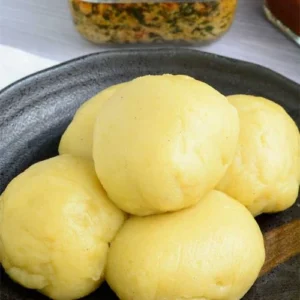
Fufu is a West African side dish, commonly enjoyed with a variety of flavorful soups and stews. Made from starchy vegetables like cassava, yams, or plantains, fufu is pounded into a smooth, stretchy dough. It is traditionally eaten with your hands, forming small balls to scoop up the accompanying soup.
This dish is a symbol of unity, tradition, and hospitality in various African communities. I tried it a few months ago and ever since then, I’ve been making it by myself every Thursday.
Origins & Historical Significance
Fufu’s roots trace back to pre-colonial West Africa, with historical records indicating its presence in regions now known as Ghana, Nigeria, and Ivory Coast. Originally, the dish was made from yams, which were pounded into a smooth, elastic dough.
Over time, the introduction of cassava by Portuguese traders during the 16th century influenced its preparation, adding diversity to its ingredients and methods. This historical journey highlights Fufu’s adaptability and enduring importance in African cuisine.
Cultural Significance

Fufu is a cultural emblem. In many African societies, it symbolizes hospitality and community. Serving fufu to guests is a gesture of respect and welcome, reflecting the host’s generosity and culinary skills. During communal meals, the act of sharing fufu fosters a sense of unity and togetherness, reinforcing social bonds and cultural heritage.
The process of sharing a meal, particularly one as significant as fufu, serves to strengthen relationships and build community ties. This cultural practice of communal eating is central to many African societies, where the shared experience of dining transcends mere nourishment and becomes an act of connection and cultural expression.
Fufu in Ceremonial Contexts
Fufu often features prominently in traditional ceremonies and celebrations. It is a staple at weddings, funerals, and festivals, where it is served alongside other traditional dishes. The preparation and sharing of fufu during these events are deeply symbolic, representing abundance, prosperity, and communal harmony.
Regional Variations
While fufu is a common dish across West Africa, regional variations exist, each adding a unique twist to the traditional recipe. In Ghana, for example, fufu is often made with a combination of cassava and plantains, resulting in a slightly sweet flavor. In Nigeria, it is commonly paired with rich, hearty soups like egusi or bitterleaf soup.
These regional differences highlight the adaptability of fufu and its ability to reflect the culinary identity of different communities. Each variation of fufu tells a story of local ingredients, culinary techniques, and cultural influences, making it a dish that is both diverse and deeply rooted in local traditions.
Ingredients & Preparation

Fufu is traditionally prepared by boiling starchy vegetables like cassava, yams, or plantains until they are soft. These are then pounded using a mortar and pestle until a smooth, elastic consistency is achieved. The pounding process, though labor-intensive, is crucial as it transforms the boiled vegetables into a cohesive dough-like mass.
In modern times, food processors or instant fufu flour have become convenient alternatives. Despite technological advancements, the traditional pounding method is still cherished for its ability to bring out the dish’s distinctive texture and flavor, making preparation a communal activity that strengthens family bonds.
The rhythmic pounding, often accompanied by singing or conversation, turns the preparation of fufu into a social event, connecting generations and preserving cultural practices.
Culinary Versatility

Fufu’s versatility makes it an ideal accompaniment to various soups and stews. Popular pairings include peanut soup, egusi soup, palm nut soup, and okra soup. Its neutral flavor profile allows it to absorb and complement the rich, savory, and sometimes spicy flavors of these dishes, enhancing the overall dining experience.
This adaptability underscores Fufu’s role as a cornerstone of African cuisine, capable of harmonizing with a wide array of flavors and ingredients. Whether served with a spicy tomato-based stew or a mild vegetable soup, fufu’s ability to meld seamlessly with different dishes makes it a staple on dining tables across the continent.
Nutritional Value

| Nutrient | Amount per Serving |
|---|---|
| Calories | 180 |
| Carbohydrates | 45g |
| Protein | 1g |
| Fat | 0g |
Fufu is a rich source of carbohydrates, providing energy essential for daily activities. Depending on the primary ingredient, it can also offer dietary fiber, vitamins, and minerals. For instance, cassava-based fufu is high in vitamin C and manganese, while yam-based fufu provides potassium and vitamin B6.
Despite its high carbohydrate content, fufu can be part of a balanced diet when consumed with nutrient-dense soups and stews, contributing to overall health and well-being.
The nutrient profile of fufu can vary significantly based on the ingredients used, but its role as a primary energy source remains constant, highlighting its importance in the diet of many African communities.
Traditional Recipe

Fufu: A Traditional West African Side Dish
Equipment
- 1 Large pot or saucepan
- 1 Wooden spoon (or fufu stick)
- 1 Mortar and pestle (for traditional pounding)
- 1 Blender or food processor (optional for modern preparation)
Ingredients
- 2 cups cassava (or yams or plantains), peeled and cubed
- 2 cups water (for boiling)
- 1 teaspoon salt (optional)
Instructions
- Prepare the Cassava (or alternative):Peel the cassava (or yams/plantains) and cut into small, uniform cubes for even cooking. This ensures the right consistency for the fufu.

- Boil the Cassava:Place the cubed cassava in a large pot and cover with water. Bring to a boil over medium heat and cook for 20–30 minutes, or until soft and tender.

- Drain and Mash:Drain the cooked cassava and allow it to cool slightly. Using a mortar and pestle, pound the cassava until smooth and elastic. If you’re using a blender, blend small amounts at a time, gradually adding water until a stretchy consistency is achieved.

- Cook the Fufu Dough:Return the mashed cassava to a clean pot. Stir it over low heat with a wooden spoon (or fufu stick) until the mixture becomes firm, smooth, and lump-free. This should take about 5–7 minutes.

- Shape and Serve:Wet your hands and shape the fufu into small, round balls. Serve immediately alongside a flavorful soup or stew of your choice.

Video
Notes
- Texture Control: The key to good fufu lies in its texture—smooth, stretchy, and lump-free. Be careful not to overcook the cassava to maintain the right consistency.
- Blending Tip: If using a blender, start with small water additions to avoid making the fufu too watery.
- Traditional Pounding: If you have access to a mortar and pestle, try the traditional method for a more authentic texture and experience.
In Summary
If you’ve never tried Fufu, I encourage you to seek it out. Not only will you experience a rich, flavorful dish, but you’ll also get a taste of a tradition that has been lovingly passed down through centuries. And for those of us who grew up eating it, fufu will always be a reminder of home, family, and the simple joys of life.











